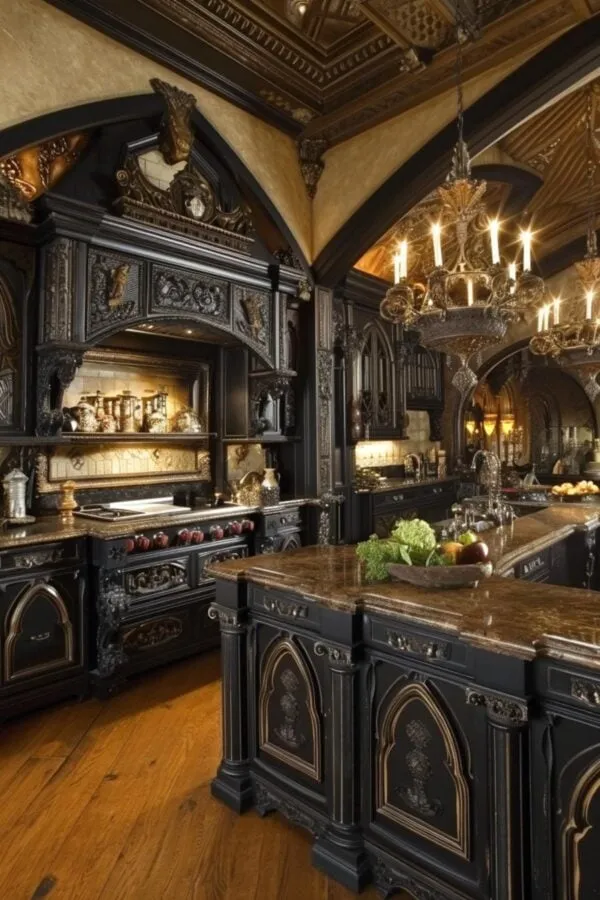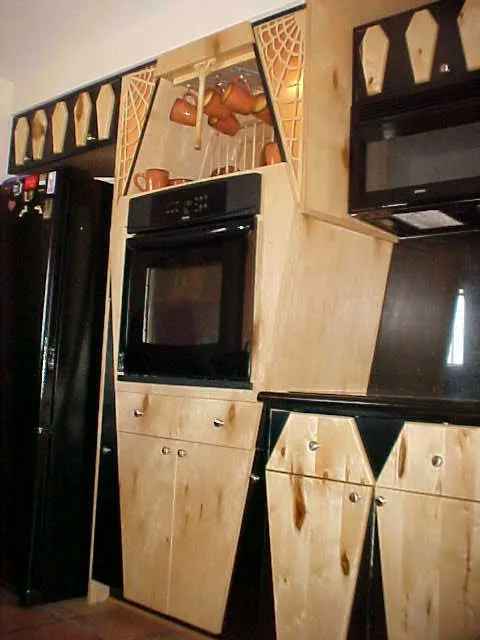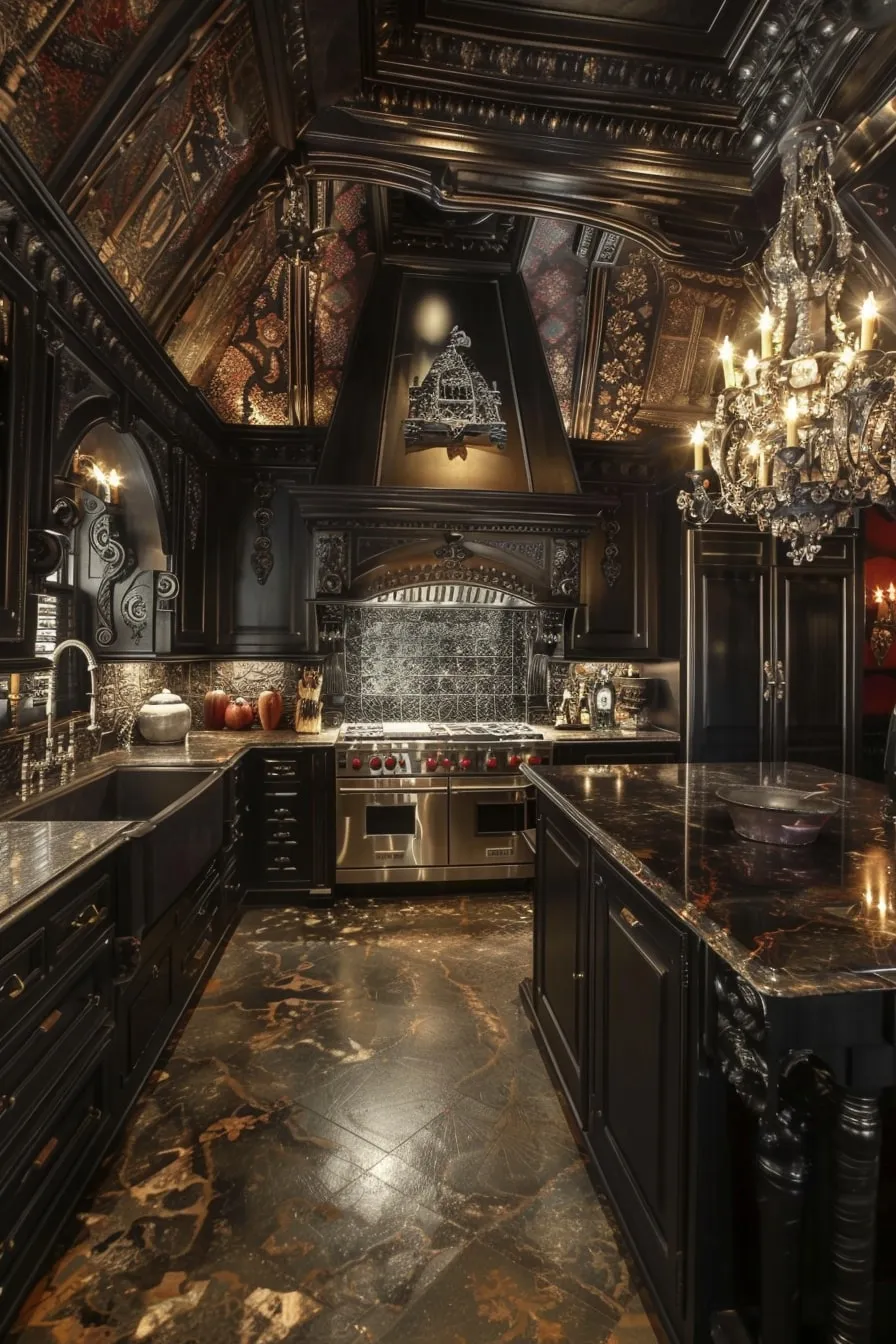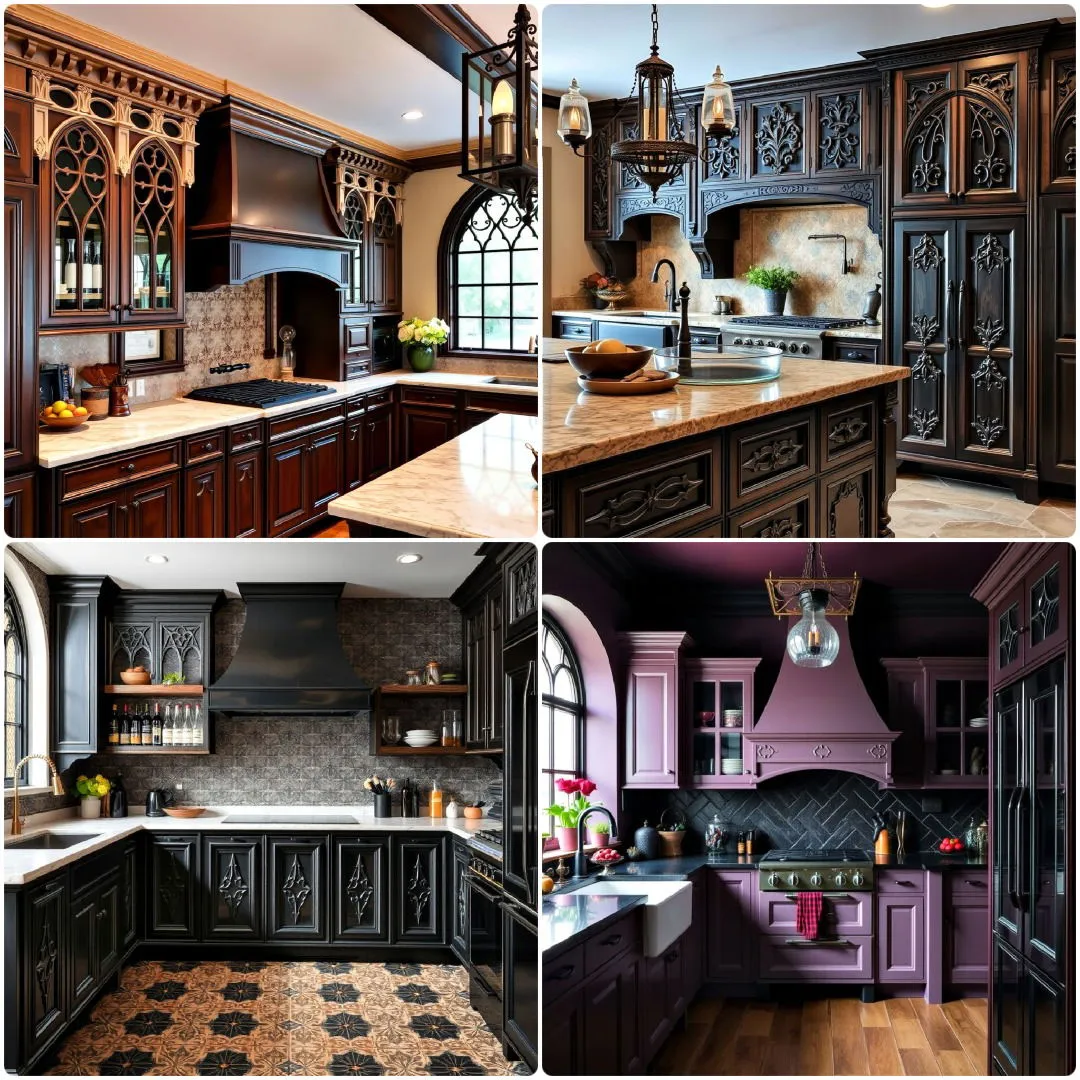Embracing Gothic Kitchen Decor
Transforming your kitchen into a gothic sanctuary is a bold and exciting endeavor. It’s about embracing a sense of drama, mystery, and history within the heart of your home. Gothic kitchen decor is not just a style; it’s an atmosphere. It speaks of a bygone era, of grand castles and dimly lit halls, now reimagined for the modern home. It’s a chance to create a space that is both visually stunning and deeply personal, reflecting your unique taste and appreciation for the extraordinary. This style provides a striking contrast to the often minimalist and sterile aesthetic of contemporary kitchens, offering a haven of comfort and character.
The gothic aesthetic is often associated with dark and moody interiors, but the key to a successful gothic kitchen lies in balancing these elements with practicality and comfort. Think about the functionality of the space. While the goal is to create a visually captivating environment, ensure your kitchen remains a practical and enjoyable place to cook, dine, and entertain. Consider how natural light interacts with the darker elements, and the overall flow of the space. The beauty of gothic kitchen design lies in its adaptability. It allows for a range of interpretations, from subtle nods to the style to full-blown gothic transformations, each tailored to your individual preferences and the specific character of your kitchen.
Defining the Gothic Aesthetic
The gothic aesthetic is characterized by its dramatic flair, embracing elements of the medieval period and the romantic movement. It’s a style rich in history and symbolism, offering a unique blend of opulence and mystery. Think about the core elements of gothic design. It is usually inspired by the architecture of cathedrals and castles, featuring pointed arches, ornate details, and a sense of verticality. This is mirrored in kitchen design through the use of dramatic shapes and imposing structures. The style is defined by its embrace of darkness and the play of shadow and light, creating an ambiance of both elegance and intrigue. Texture is also a vital component of the gothic aesthetic.
Gothic kitchens are not merely spaces; they are experiences, meant to evoke a sense of awe and introspection. This aesthetic isn’t for the faint of heart; it’s a bold statement of personal style. It allows homeowners to express a deep appreciation for history and artistry. The gothic style draws on a rich palette of materials, colors, and details, blending them to create a space that is both visually striking and deeply personal. By understanding the core principles of this aesthetic, you can begin to visualize how you will integrate it into your own kitchen. The goal is to create a cohesive and captivating space that truly reflects your unique style and vision.
Key Elements of Gothic Kitchen Design

When designing a gothic kitchen, several key elements come together to create a cohesive and captivating space. The interplay of these elements is essential for capturing the essence of gothic style. It typically involves the use of dark, rich colors, and the incorporation of intricate details inspired by medieval architecture. One of the hallmarks of gothic kitchen design is the use of ornate hardware, such as wrought iron handles and cabinet pulls. These details add a touch of historical elegance and reinforce the gothic aesthetic. The design also incorporates unique architectural features, like pointed archways or faux stone finishes, to create a sense of depth and drama.
To successfully create a gothic kitchen, incorporate details that evoke the atmosphere of a medieval castle. This may include the use of heavy, dark wood furniture, stone countertops, and metal accents. Lighting plays a crucial role in this style, as it dictates the ambiance and enhances the dramatic effect. Consider the placement of dramatic pendant lights above the island or the use of sconces to cast intriguing shadows. The careful combination of these elements – color, material, detail, and lighting – is what truly brings the gothic aesthetic to life within the kitchen space.
Dark and Dramatic Color Palettes
Color is a foundational aspect of gothic kitchen decor. Embracing a dark and dramatic color palette is key to establishing the desired atmosphere. Deep shades like black, charcoal gray, burgundy, and forest green are often the base colors. These hues provide a rich and moody backdrop that’s characteristic of the gothic style. These colors are then often contrasted with metallic accents or lighter shades to create visual interest and depth. Think about how these colors interact with natural light. If your kitchen receives a lot of light, the darker colors will absorb it, further enhancing the dramatic effect.
The color scheme is not solely about the walls. The gothic kitchen style extends to cabinets, countertops, and even appliances. Consider painting cabinets in a deep charcoal or rich black. Use countertops made of dark stone like granite or marble. To create contrast, incorporate metallic accents in gold, copper, or silver. These can be seen in the hardware, lighting fixtures, or decorative elements. The use of these colors should be balanced; otherwise, the space might become too overwhelming. Consider adding touches of lighter colors, like cream or off-white, in the backsplash or textiles to create contrast and prevent the space from feeling too closed in.
Incorporating Gothic Furniture and Fixtures
The selection of furniture and fixtures plays a critical role in establishing the gothic aesthetic within your kitchen. Pieces should echo the historical influences that define the style. Look for furniture made from dark, heavy woods like mahogany or walnut. Consider pieces with ornate carvings, pointed arches, or other details that are reminiscent of medieval architecture. A large, imposing dining table with detailed legs and a dark finish will serve as a focal point in the space. The style of seating should be chosen carefully, with chairs that are designed with high backs and luxurious upholstery.
Beyond furniture, consider the fixtures. The faucet, sink, and other hardware should echo the gothic style. Fixtures with an antique finish or those crafted from materials like wrought iron or brass will complement the style. Furthermore, think about incorporating details like arched doorways or windows, which are quintessential elements of gothic design. These architectural features will enhance the overall aesthetic, transforming the kitchen into a true gothic sanctuary. The combination of the right furniture and fixtures will help define the gothic character of your kitchen. With careful selection, these elements will give the space a unique, historical, and visually striking atmosphere.
Gothic-Inspired Lighting

Lighting is one of the most crucial elements to consider in a gothic kitchen, as it is vital for establishing the mood and highlighting the architectural details. Choose lighting fixtures that evoke the atmosphere of dimly lit castles and cathedrals. Think about fixtures that feature intricate designs, dark metal finishes, and perhaps even a touch of stained glass. Pendant lights with elaborate metalwork or chandeliers with a gothic design will serve as focal points, casting shadows and adding to the drama. The style of lighting should be layered. Combine ambient, task, and accent lighting to create a well-balanced space.
In a gothic kitchen, task lighting might be provided by elegant sconces placed above countertops, while ambient lighting can be achieved with a chandelier. Use accent lighting to highlight architectural features or decorative elements. Candlelight is also a key element of gothic style and can be incorporated through the use of candelabras or candle holders. Consider the placement of the lighting fixtures. Placing pendant lights above the island or dining table will add a touch of drama. Use dimmer switches to control the intensity of the light. It allows you to adjust the ambiance to suit your mood. The use of appropriate lighting will transform your kitchen into a stunning and inviting space.
Decorating with Gothic Accessories
Accessories play a vital role in bringing the gothic aesthetic to life. They offer a chance to infuse your kitchen with personality and historical charm. Choose accessories that complement the existing decor and enhance the gothic theme. Incorporate items like antique mirrors with ornate frames, adding depth and reflecting the light in the space. Use metal candle holders and candelabras to create a dramatic and romantic ambiance. Include decorative items like statues, busts, or other art pieces to create an air of mystery and history.
The careful selection and placement of these accessories can enhance the visual appeal and the character of the kitchen. Choose items that reflect the gothic style and complement the overall design scheme. For example, you could include items like vintage-style clocks, decorative plates, or even antique kitchen utensils. The style is all about details, so the accessories are important to the overall aesthetic. Make sure to choose items that are both beautiful and functional, such as decorative serving dishes or storage containers. With thoughtful selection, your accessories will transform your kitchen into a true gothic sanctuary.
Textiles and Fabrics for a Gothic Kitchen
Textiles and fabrics are crucial in softening the gothic aesthetic. They also add a touch of luxury and enhance the overall sense of comfort in the kitchen. Consider using fabrics with rich textures, dark colors, and ornate patterns to complement the design. Use velvet, damask, or brocade fabrics for curtains, cushions, or other decorative elements. These materials add a layer of opulence and luxury to the space. Consider using fabrics with dark, moody colors, such as deep reds, purples, or blacks. These colors will reinforce the gothic theme and create a cohesive design.
Another essential element to consider when choosing textiles and fabrics is the pattern. Consider fabrics with intricate patterns or motifs that evoke the gothic era, such as fleur-de-lis, gothic arches, or heraldic symbols. These patterns will add visual interest and enhance the historical charm of the kitchen. The careful use of textiles and fabrics can soften the sharp lines of the gothic aesthetic and create a comfortable and inviting space. You can introduce textiles through various elements, such as curtains, tablecloths, or upholstery. With these choices, the kitchen will be transformed into a space that is both stylish and comfortable.
Finding Gothic Kitchen Decor Online

The internet is a treasure trove of gothic kitchen decor, offering a vast selection of items to help you create your dream space. Many online retailers specialize in gothic and vintage home decor, providing a convenient platform for browsing and purchasing. Explore online marketplaces, such as Etsy and eBay, where you can find unique, handcrafted, and vintage items. These platforms are great resources for locating one-of-a-kind pieces that are difficult to find elsewhere. These websites allow you to filter your search by style, color, and price, making the shopping process easier and more efficient.
Besides specialty retailers, you can also explore larger online stores. They usually offer a range of gothic-inspired products. Websites like Amazon or Wayfair often have a selection of furniture, accessories, and decor items. Before making a purchase, make sure to compare prices, read reviews, and check the return policies. This will ensure a successful shopping experience. Use keywords when searching for items, such as “gothic kitchen decor”, “dark kitchen accessories”, or “vintage kitchen lighting”. Regularly browse various online stores to discover new products and stay inspired. Finding the right gothic kitchen decor online is a rewarding process. With careful searching, you can find everything you need to transform your kitchen.
